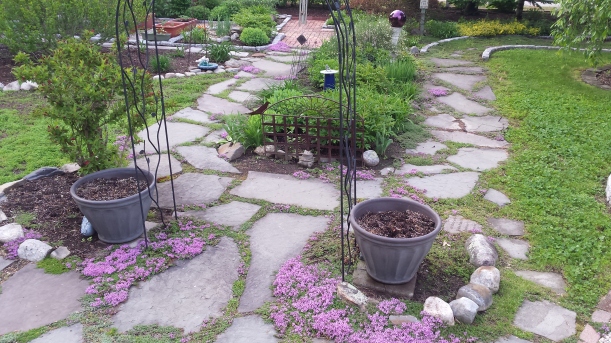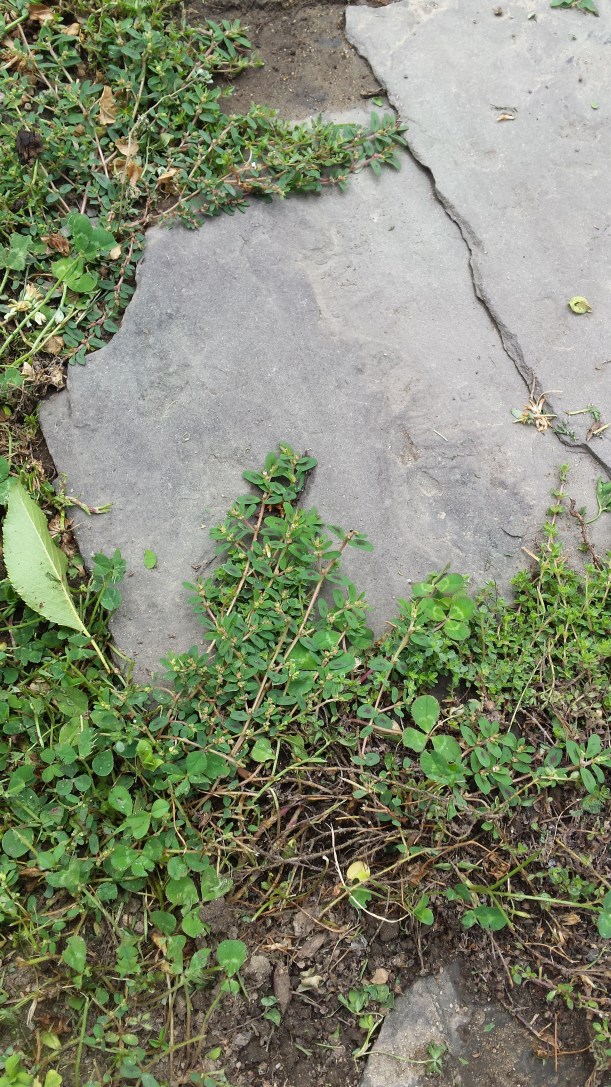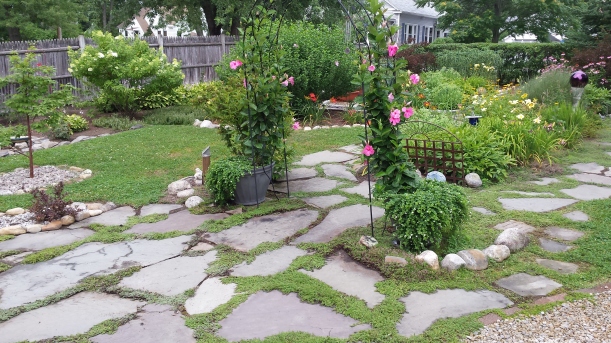Once again, a calendar is not needed when paying attention to the garden. It’s been easy to know we’re in late July because it’s time to weed the thyme.
A few years ago, we replaced bark mulched paths in the garden with blue stone. The spaces between the blue stone are perfect for planting Creeping Thyme. It spreads between the spaces of the stones, emitting a soft herbal fragrance when people and pets walk along the paths.

In late May, the thyme produces flowers bringing the stone to life, adding extra color to the late spring garden and creating patterns of purple and green in the spaces where the stones almost meet. While we’ve planted various colors of thyme – purple, white, and hot pink over the years, the thyme with purple blossoms is the hardiest and has outlived other colors over the years. We’ve also learned that while Woolly Thyme adds texture and a lighter, almost silvery color among the blue stone, it doesn’t last as long as the regular creeping thyme.
The flowers on the thyme bloom from late May until early July in our Nashua, NH garden. It’s at that point on the calendar when the garden truly transitions from spring to summer. The purple and pink colors across the garden fade as the green, orange and red plants take over.
This year, the weeds have emerged during this transition period and have been more prolific than ever. We usually see this trend later in the summer, so attribute the abundance of midsummer weeds to the ‘extreme drought’ our region experienced in 2016. (Or perhaps I’m just noticing more weeds since attending a weeding seminar with Roger Swain at the Nashua Public Library earlier this year?!)
Over the 10 days, my mother and I have spent a combined 25+ hours weeding the various beds and paths throughout the garden. Her time out there beats mine by 2:1! The challenge has been the infiltration of weeds with the thyme. In addition to the typical crabgrass, it seems the ideal impostor weed has been the spotted spurge.

You see, it’s a flat weed that starts under the thyme plants. It spreads like thyme as well. The bigger challenge: As you walk along the garden paths, it’s not easy to see until suddenly it’s huge because it’s taken over the delicate thyme planted in that space. The single deep root sends shoots that spread up to a few feet in diameter. And, it seems to happen overnight. When it does, it’s difficult to remove just the weed, so inevitably, some sprigs of thyme are pulled in the mix.
Yes, there’s also white clover mixed in too, which is my fault. However, while some gardeners consider white clover to be a weed, it’s the latest solution to the Sad Sod Situation I’ve shared in the past. (I’ll save that story update for later – but here’s a sneak preview: The second planting of lawn two years ago died during the 2016 drought. It was decided we’d fill that area with white clover last fall and this spring, and the seed shaker helped scatter a little clover to a few paths where it wasn’t intended to grow.)
Even after hours and hours (and yes, more hours) of weeding through the thyme over the past week…sometimes feeling like I was wasting time…I must admit there’s something cathartic about the process of weeding. It allows me to get incredibly close to to the garden and forces me to slow down. It takes time to find the roots of weeds and fully remove them. Additionally, when working so close to the ground, it’s easier to notice soil conditions, pest issues, and beneficial garden creatures including dragonflies, toads, and worms.
That said, I’m thrilled the worst part of weeding thyme is behind us so we can spend the rest of the summer enjoying thyme!

